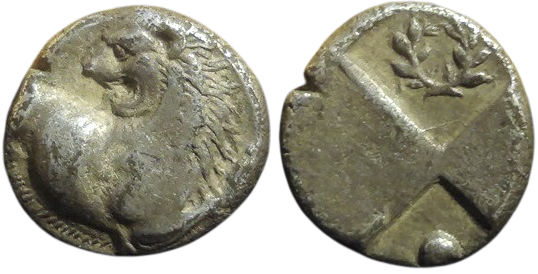
Ref: McClean 4076–7; HGC 3, 1437
Pedigree: Ex-Gitbud & Naumann GmbH, Pecunem Auction 21, Lot 985 (part, Munich, 7 Sep 2014)
Album: Sold Coins
Categories: Greek Coins
Tags:

Ref: McClean 4076–7; HGC 3, 1437
Pedigree: Ex-Gitbud & Naumann GmbH, Pecunem Auction 21, Lot 985 (part, Munich, 7 Sep 2014)
Album: Sold Coins
Categories: Greek Coins
Tags:
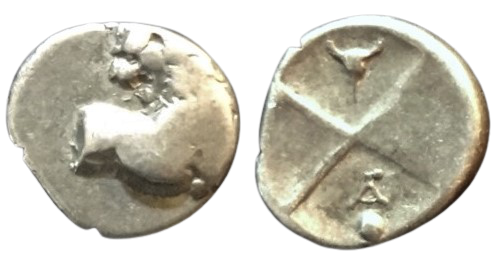
Pedigree: Ex-Gitbud & Naumann GmbH, Pecunem Auction 21, Lot 985 (part, Munich, 7 Sep 2014)
Album: Sold Coins
Categories: Greek Coins
Tags:
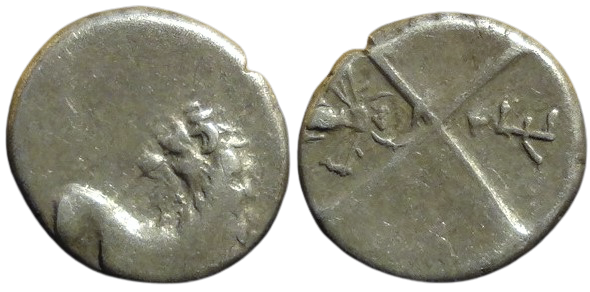
THRACE, Chersonesos. Circa 386-338 BC. AR Hemidrachm
Obv: Forepart of lion right, head left
Rev: Quadripartite incuse square with alternating raised and sunken quarters; pellet and EY monogram in one sunken quarter, bee in other.
Ref: Unpublished variant, unique to our research. Cf. McClean 4116 variant (monogram orientation, pellet placement).
Note that the EY monogram is “facing outward” from the center, oriented 180 degrees from the normal placement of McClean 4116. The pellet is also placed (and shaped?) differently from published examples.
Pedigree: Ex-Gitbud & Naumann GmbH, Pecunem Auction 21, Lot 985 (part, Munich, 7 Sep 2014)
Album: Sold Coins
Categories: Greek Coins
Tags:
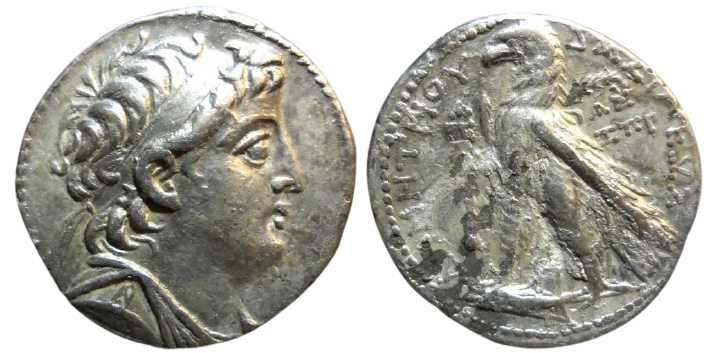
Pedigree: Ex-Roma Numismatics e-Sale 11, Lot 363 (part; London, 23 August 2014)
Historical Notes: Struck until the death of Demetrios in 126/125, after which the Shekel of Tyre replaced his tetradrachm.
Upon being deposed as Seleukid King, Demetrios II fled to Tyre, where he expected to find safety. Instead, upon arrival, the local prefect ordered him killed while still in his ship.
The type was the stylistic basis for, and predecessor of, the “Shekel of Tyre” of New Testament fame. The Seleukid tetradrachms of the mid 2nd century had become a standard currency of international trade in the E. Mediterranean. When the Seleukid Empire fell, the local Tyrians continued striking the popular coinage, simply substituting the image of local patron deity Herakles-Melqart on the obverse in place of the portrait of Seleukid dynasts, and replacing the Seleukid Era-date with Tyre’s year of independence from the Seleukids, and the legend with a slogan of Tyre’s holy inviolability.
The Seleukid type was, in turn, influenced by the Ptolemaic Tetradrachm of similar style. Even after Pompey Magnus took Tyre for Rome in 64 BC, the city continued to issue the iconic Shekel for another 130 years. When production ceased in 65/66 AD, the design of the coin remained strongly influential for Roman Provincial Tetradrachms well into the 3rd cent.
Album: Sold Coins
Categories: Greek Coins
Tags:
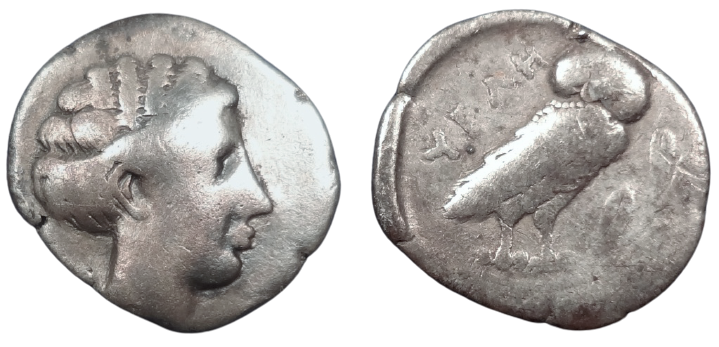
Sold from our JJFN Ebay store, 3 Dec 2012
Lucania, Velia AR Drachm (3.69g, 18.5g, 6h). Circa 440 – 400 BCE.
Obverse: Head of nymph right, hair arranged in waves.
Reverse: YEΛH. Owl standing right, head facing, on olive spray with two leaves.
References: Williams 180 (O114/R138); HN Italy 1272 (var. right/right); SNG Ashmolean 1147; SGC (v1) 251.
Die matches: Rev (maybe obv), CNG 386-42, later Aegean [Vcoins SKU: 071813] (see also Bertolami EA 44, 91).
Provenance: Ex Colin E. Pitchfork Collection, CNG EA 233 (26 May 2010), 606.3; VAuctions Sale 284 (12 Jul 2012), Lot 10; Jackson & Jacobs Family Numis. (Tucson, AZ, 3 December 2012; ebay item #330831837178)
Notes: Rare type. Example of scarcer, earlier, transitional period style between the older archaic nymph and later depictions on Velian and other Lucanian (important region in southern Italy) coinage, often with tied or diademed hair. (The same is true of the owl on Velian and Lucanian drachm and nomos series, continuing into the 3rd century.) The Velia-Owl drachms continued to be minted throughout the 5th and 4th centuries, with variation in the style over time.
Album: Sold Coins
Categories: Greek Coins
Tags:
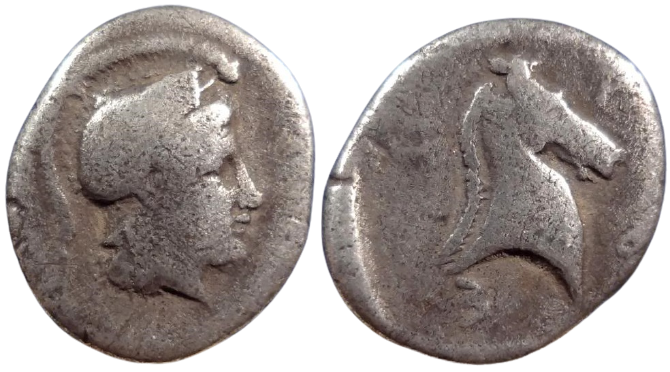
Purchased from Gitbud & Naumann, 10 Feb, 2013.
Sold from our JJFN Ebay Storefront (item #330874962559; Champaign, IL, 11 March 2013)
Album: Sold Coins
Categories: Greek Coins
Tags:
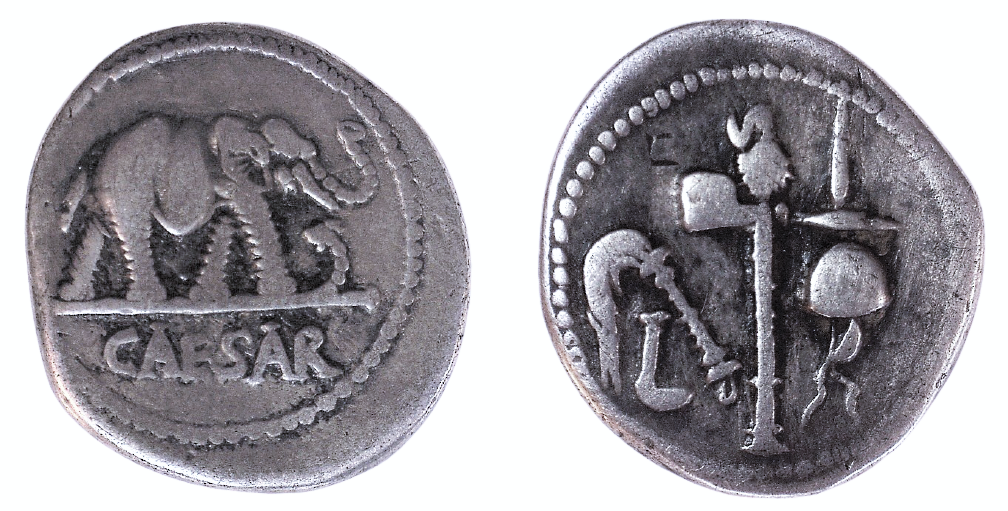
Julius Caesar (Dictator, 49 – 44 BC) AR Denarius (3.49g, 17mm, 1h). Mobile military mint traveling with Caesar in Northern Italy, 49 BC.
Obv: Elephant advancing right, trampling on horned serpent or carnyx (Gallic war trumpet). CAESAR in exergue.
Rev: Pontifical emblems – ladle (simpulum), sprinkler (aspergillum), axe (securis) surmounted by a wolf head, and priest’s hat (apex).
Ref: RSC 49; Crawford 443/1; Sydenham 1006; Sear CRI 9 (ref. in error in K. Davis 74); Babelon 1885, p10, Julia 9.
Pedigree: Ex-Kirk Davis Catalog #74, Lot 65 (12 Nov 2019); VAuctions Triskeles Sale 28, Lot 260 (21 Jun 2019).
(Mobile users, open in new tab or go back & click “Read More”.)
Album: All Coins
Categories: Roman Coins
Tags:
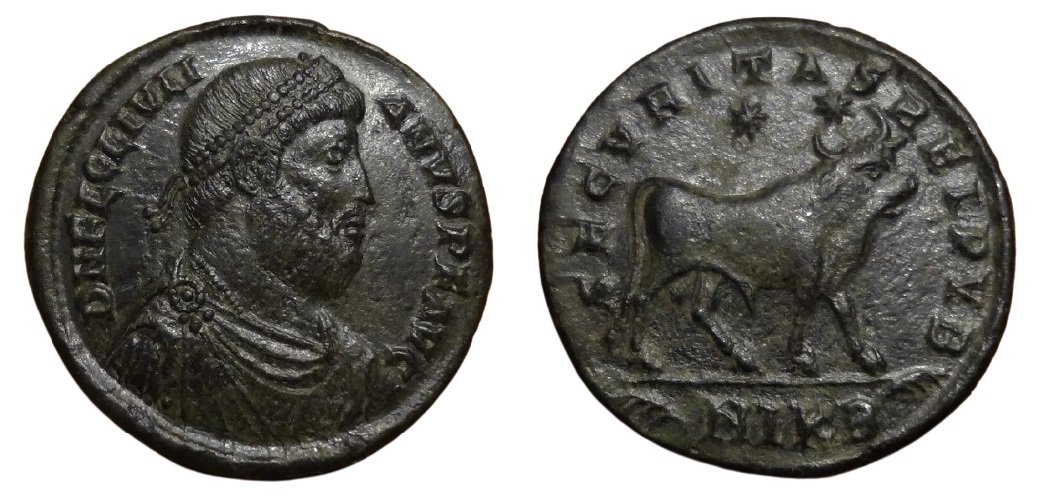
Julian II “The Apostate” (AD 360 – 363) AE Double-Maiorina (8.2g, 29mm). Nicomedia, 361-363 AD.
Obv: DN FL CL IVLIANVS PF AVG. Pearl-diademed, draped & cuirassed bust right.
Rev: SECVRITAS REIPVB / NIKB, palm branch to either side in exergue. Apis bull standing right, two stars above.
Ref: RIC 121.
Pedigree: Acquired circa 2010.
Album: All Coins
Categories: Roman Coins
Tags:
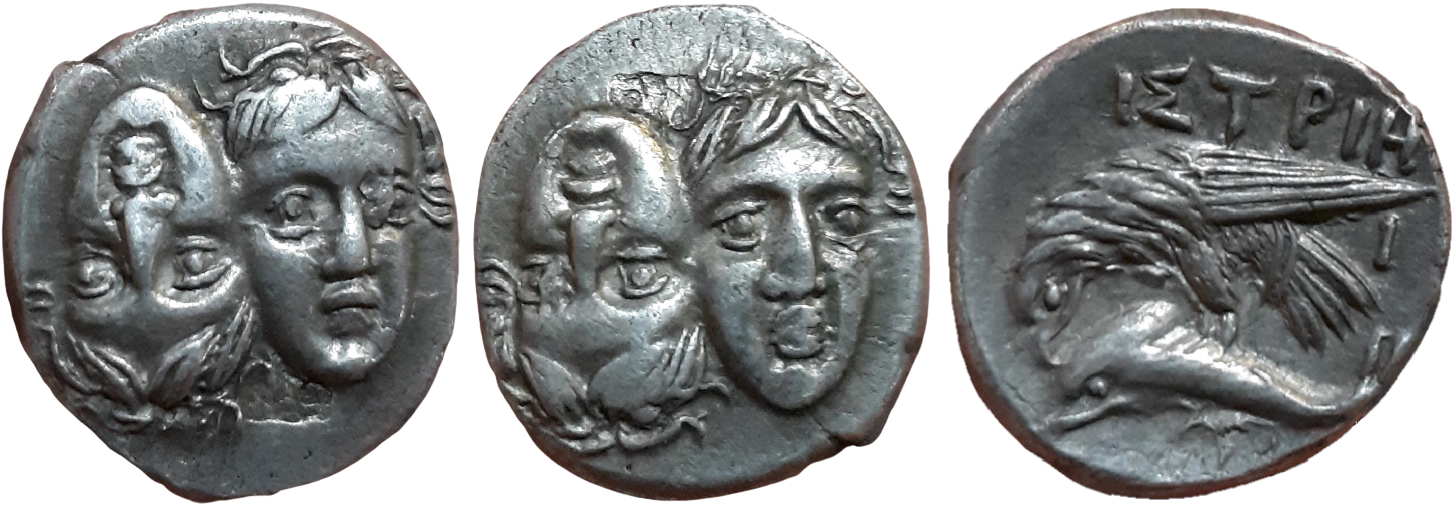
Moesia, Istros AR Drachm (5.0g, 19.5mm, 3h). Circa 340 – 313 BC.
Obv: Two facing male heads, the left inverted.
Rev: IΣTPIH. Sea-eagle left, grasping dolphin with talons. Behind eagle, right: I. Below dolphin: inverted ΑΠ (obscured).
Ref: Dima Group IV, Subgroup III, 16; AMNG I 418. Cf. SNG BM Black Sea 246-249.
Pedigree: Ex-Palmyra Heritage/Morris Khouli Gallery (9 September 2014)
Die matches: Both: CNG e-98, 19 (29 Sep 2004), rev re-engrave. Obv: Hirsch 264, 125 (25 Nov 2009); Rauch 212, 129 (20 Sep 2012); CNG e-387, 47 (30 Nov 2016), re-engraved; e- 391, 76 (15 Feb 2017), Rev re-engraved (?); Pegasi BBS 152, 48 (22 Aug 2017). Rev: Gorny & Mosch 152, 1238 (10 Oct 2006); NY Sale 14, 84 (10 Jan 2007); Naumann 3, 27 (5 May 2013); 14, 51 (2 Mar 2014).
Album: All Coins
Categories: Greek Coins
Tags:
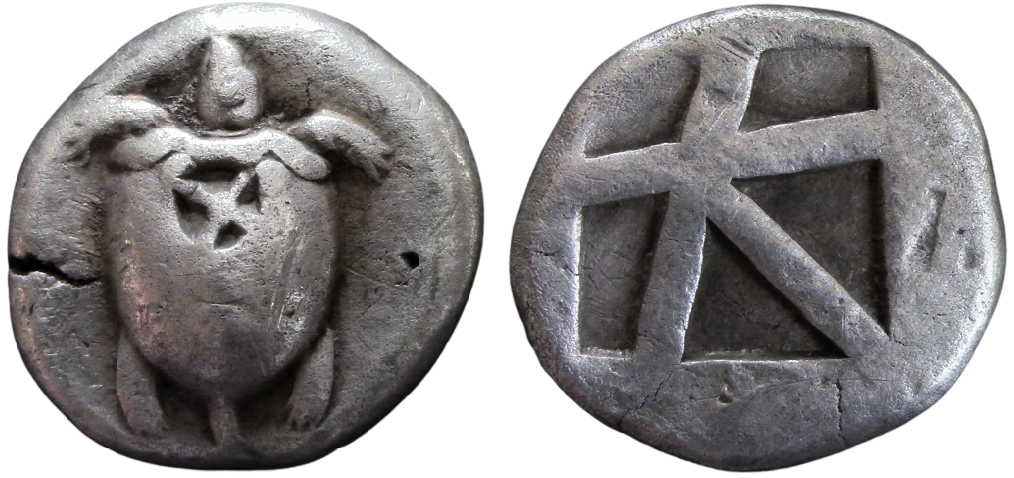
Attica, Aegina (Saronic Gulf Islands) AR Stater (12.19g, 21.5mm, 7h). Circa 480-457 BC
Obverse: Sea turtle, head turned sideways in profile, with trefoil collar and ‘T-back’ design, column of pellets on shell. Banker’s mark: Incuse circle with cross and four sunken compartments.
Reverse: Large incuse skew pattern with five sunken compartments.
References: HGC 6, 435; Meadows Aegina Group IIIa; Milbank period III, pl. 1, 14-15 (cf. 13); SNG Copenhagen 507; SNG Lockett 1970. Banker’s Mark: Milbank Counterstamp 15.
Pedigree: Ex-Nomos AG Obolos 16, Lot 772 (Zurich, 11 Oct 2020)
Numis. & Hist. Notes: Aegina’s classic archaic turtle Staters, probably first struck about 550 BC, were the earliest coins of Europe. They were influenced by the newly developed technology of coinage in Lydia, an ally with whom Aegina had extensive trading experience. The present coin shows a later, distinctively 5th century design.
Date ranges given vary by source (470/65-445/40 BC given by Nomos AG; see also Sheedy 2015). Milbank (1924) and others use 480-457, bracketed by the Battle of Salamis at the end of the Persian Wars, until Athens’ Siege of Aegina, during the Peloponnesian War. (See also Sheedy [2015] for a recent introductory review.)
The Banker’s Mark on this example (Milbank Counterstamp 15) is an interesting complement to the incuse square imagery on the reverse of this series (see additional examples in Leu e-13, 241 [15 Aug 2020] & Elsen 138, 79 [8 Sep 2018]).
See also our later Land Tortoise coinage of Aegina
[Alternate spelling: Aigina.]
Album: All Coins
Categories: Greek Coins
Tags: